ANTD.VN - The first time coming to Sa Pa, a reporter from the Korean magazine National Geographic Traveler was captivated by the majestic beauty of Fansipan peak, calling conquering the roof of Indochina a "journey through the clouds".
Journey to "lift the mist" to Fansipan peak
In his fascinating journey to explore Vietnam recently published in the Korean magazine National Geographic, reporter Cha Seong Min was particularly impressed by Sa Pa and Fansipan peak. He described his journey to explore Sa Pa and Fansipan peak – the roof of Indochina – as full of surprises and the more he “lifted the clouds and mist”, the more interesting things he saw.
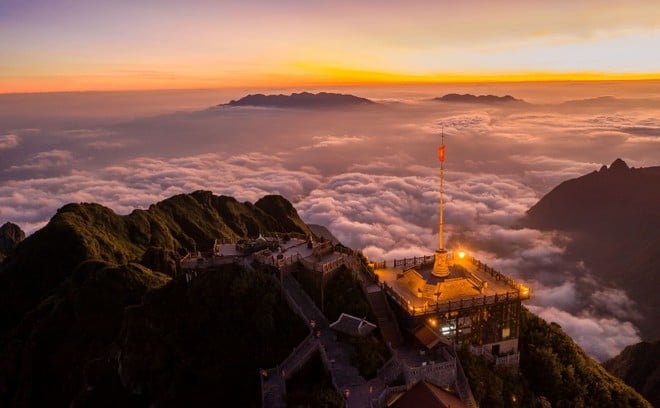 |
| Sea of clouds on the "roof of Indochina" |
Sa Pa is like a “stop in the middle of the sky” before conquering Fansipan peak, for two groups of people: those who are preparing to climb Fansipan and those who have finished climbing. For those who are preparing for the journey to the “roof of Indochina”, Sa Pa offers fresh air, helping them relax and recharge before the challenge. For those who have completed the climb, this is an ideal resting place to enjoy the fruits of their labor, sip a cup of hot tea and immerse themselves in the majestic scenery of the Northwest.
Cha Seong Min's journey to conquer Fansipan consisted of three stages: starting from Sun Plaza - which the male reporter compared to the Big Ben tower of England, continuing with the Muong Hoa mountain train, before setting foot on the "roof of Indochina" and admiring the majestic landscape.
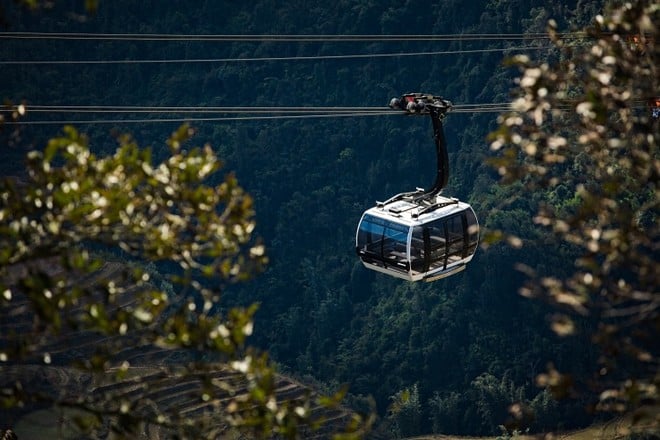 |
| Tourists can conquer Fansipan peak thanks to the convenient cable car system. |
The male reporter was particularly impressed with the Fansipan cable car - a 3-wire cable car system with the largest difference in altitude between the departure and arrival stations in the world, taking visitors across the sea of clouds to reach the "roof of Indochina" in just a few minutes. "In just 15 minutes, the Fansipan cable car took us to an altitude of 3,143m, opening up a magical world in the middle of the sky," the author of the article shared. He also enjoyed repeating the local saying: "You must have three generations of good fortune to be able to conquer Fansipan peak in clear weather," because when setting foot on the top, visitors will experience the feeling of "tearing the blind bag", the scenery can be mysterious when immersed in fog and sea of clouds, or if you are lucky, you can witness the beautiful sea of clouds, "exposing" the layered mountains of the Northwest under the clear blue sky. The author also suggests that visitors should enjoy a cup of hot chocolate at Cafe Du Soleil Sapa, experiencing the highest altitude cafe in Indochina.
A Korean reporter was amazed by the giant Buddha statue on top of Fansipan, describing it as “a place that radiates a different light, containing the deepest wishes of people”. The 21.5m tall Amitabha Buddha statue is the highest bronze Amitabha Buddha statue in Asia, not only having great cultural and spiritual significance but also becoming an attractive destination for tourists when visiting Sa Pa.
The things that make Sapa
Not only being fascinated by the majestic scenery of Fansipan peak, the famous Korean travel magazine also takes tourists to explore the unique cultural life of ethnic minorities in Sa Pa. To experience this, before going up or after going down from Fansipan peak, visitors can visit Ban May near the cable car station. This is the community living space of the H'Mong, Dao, Tay, Giay, Xa Pho, Mong Dien Bien, and Ha Nhi ethnic groups.
 |
| Visitors can experience the culture of ethnic minorities in Sa Pa right at Ban May. |
Not only can visitors admire the traditional architecture, they also have the opportunity to experience the cultural quintessence through beliefs, cuisine, handicrafts and the typical songs and dances of each ethnic group. "Here, we encountered the Red Dao people diligently weaving, while the sound of bamboo flutes echoed through the mountains and forests, creating a scene imbued with the Northwest of Vietnam," the male reporter shared. He was also impressed with apple wine - a specialty with the strong flavor of the "foggy town".
In particular, the dishes in Ban May such as sturgeon hotpot, stir-fried bamboo shoots and steamed black chicken with pumpkin are very popular with the male reporter. Besides nature and culture, reporter Cha is also impressed with the unique architecture of Sa Pa, where indigenous features and European influences blend. Once the "summer capital" and a resort for the French elite, Sa Pa owns many French-style constructions such as the ancient Stone Church or the Hotel de la Coupole - MGallery, contributing to the special attraction of this land.
Like a "precious gem" in the heart of Sa Pa, Hotel De La Coupole takes visitors back in time to Indochina in the 1930s with a luxurious, artistic and nostalgic space. Designed by famous architect Bill Bensley, the hotel is a subtle blend of the cultural colors of the Northwest ethnic minorities and the charm of high-class French fashion in the 1920s and 1930s. Each design line tells the story of the life of the French among the H'Mong, Dao, Xa Pho, Tay, Giay tribes..., creating a space that is both splendid and has the breath of the Northwest mountains and forests. Previously, the Korean magazine Hankyung also described this hotel as "like a maze, bringing a feeling similar to traditional Korean Hanok houses". Or The West of Australia likened this place to the Switzerland of Vietnam.
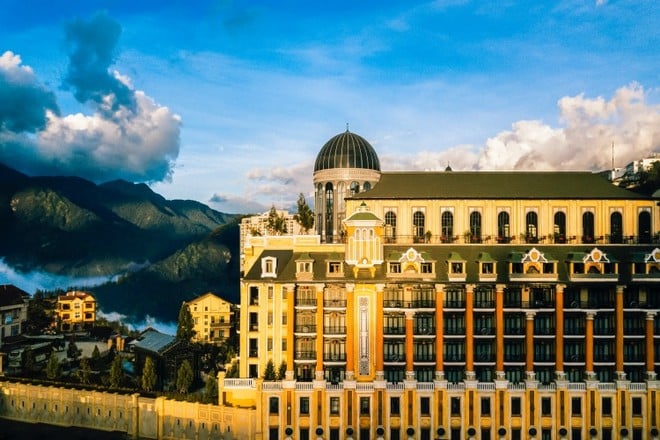 |
| The majestic and splendid appearance of Hotel De La Coupole in the middle of Sa Pa |
In addition to the above itinerary, National Geographic also suggests a 12-hour journey to explore Sa Pa, starting with a relaxing morning around the central lake, continuing with a trip to conquer O Quy Ho Pass and explore Cat Cat Village. At the end of the day, visitors can stroll around the night market, enjoy specialties and shop for souvenirs.
Recently, Sa Pa in general and Fansipan in particular have received many compliments from leading Korean magazines such as National Geographic, ELLE, GQ, Hankyung... This shows the special attraction of the destination to international tourists, especially Korean tourists.
Sa Pa in late spring and early summer is currently ablaze with flowers, from cherry blossoms to rhododendrons, and then Sa Pa climbing roses in late April and early May. Many flower festivals are also taking place at Fansipan, offering visitors endless discoveries.
Source: https://www.anninhthudo.vn/national-geographic-choang-ngop-voi-su-ky-vi-cua-dinh-fansipan-post607035.antd


![[Photo] Prime Minister Pham Minh Chinh chairs conference on anti-smuggling, trade fraud, and counterfeit goods](https://vphoto.vietnam.vn/thumb/1200x675/vietnam/resource/IMAGE/2025/5/14/6cd67667e99e4248b7d4f587fd21e37c)







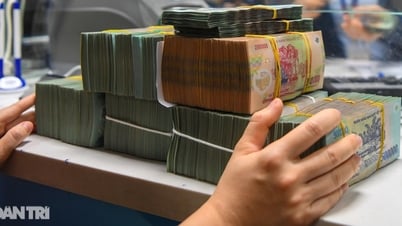












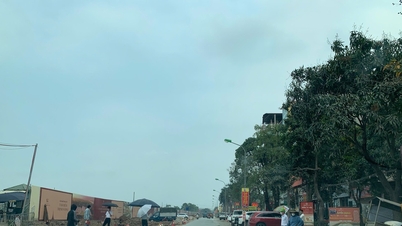







































































Comment (0)